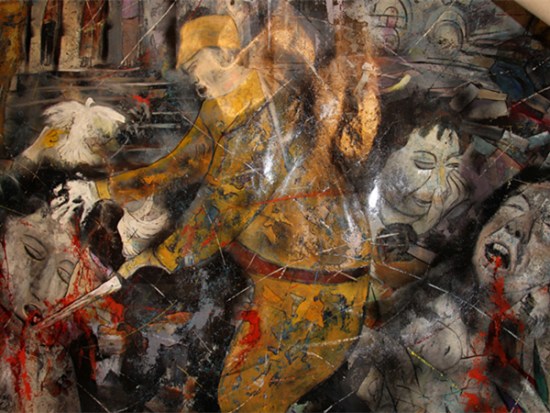
French painter Christian Poirot has created an emotional painting to commemorate the Nanjing Massacre.
"I am a French artist having studied discursive knowledge through the study of reasoning. Regarding a scene of massacre, my characters wear many emotions, such as pain, fear, anguish, horror and terror," he continued.
The painting he created was full of dark, turbulent, and fragmented images portraying dozens of scenes from the massacre. On the canvas, viewers see Japanese soldiers killing civilians for sport and amusement, while solitary children look on in fear after having lost their families.
"With my painting, I think one sees the scenes, one sees the pain, all the feelings of fear, hate, and anguish," Poirot explained.
The artist discovered his own limits, however, finding that he could not depict some of the more brutal acts recorded in histories of the massacre. Instead, he painted doves flying up from those being killed, as a sign of peace and life, even as the victims lost their bodies.
"It's as if they are saying, you can take my body, but never my soul!" he declared.
He explained that he had originally wanted to have the doves form a geographical map of China, but that the format of the painting had made it impossible, even if he hoped that viewers could still imagine what he had not been able to include.
"A painting, first, it is always the joy of the eyes which attract, then comes the joy of the spirit which captivates, and after, the joy of the heart holds on to the work," the painter declared.
The decision to donate the painting was obvious to Poirot. Even though it would easily be valued at 300,000 euros or more, the painting represented a gesture of friendship toward China.
"The donation was simply because I came to know the Chinese people, who touched me with their kindness," he affirmed. Moved by the people who had welcomed him during his trips through China, he felt that such a gift was the strongest way to demonstrate his appreciation.
The French painter did not always have a relationship with China. It was only in 2009, however, when a friend invited him to visit China, that Poirot first experienced Chinese hospitality and culture. He has visited as many as nine times since, often painting joyous depictions of the Chinese cityscapes while there. Indeed, the macabre images of "Deliverance" differ from his usual work, which is bright, colorful, and suggesting happiness.
According to the painter, "Deliverance" will be a part of the collection of the Nanjing Memorial Hall, and he hopes it will one day be put in the permanent exhibition in order for visitors to see his rendering of the massacre. He is currently working on new paintings, including a collaborative project with a Chinese painter.
A former employee in the chemical industry, Poirot began painting at the age of 26 when an accident on the job left him unable to return to work. Studying first at the regional level and then at the national level in Paris, the native of Alsace quickly developed both passion and technique.
In his career Poirot enjoyed growing success, with prizes earned in France and the United Kingdom, as well as gallery showings in several countries. He was honored when two paintings on exhibition in Paris were selected by former French President Jacques Chirac for his collection.


















































